Abstract
The current challenges facing large-diameter timber forests include low yield and low eco-economic benefit. As a result, the development of large-diameter timber forests has become one of the most important strategies for the development of forestry in China. The present study employed bibliometric analysis and Citespace software v.6.1.R3 to examine the literature from CNKI and WOS databases spanning 2002–2021. This analysis aimed to identify the research hotspots and trends in large-diameter timber trees while providing theoretical support and guidance for developing large-diameter timber forests. The research results showed the following data. (1) The number of articles published increased year by year, approximately 4.8 times in 20 years. (2) The journal “Forest Ecology and Management”, where the number of papers is up to 53, has a significant impact on the field of large-diameter timber research. The Tropical Forestry Experimental Center of the Chinese Academy of Forestry and the Wageningen University and Research in the Netherlands possess strong research capabilities, with average citation frequencies of the articles of 26.8 and 51.5, respectively. (3) Research on large-diameter trees focuses on “large-diameter timber cultivation technology and cultivation measures”, “forest conservation management”, “large-diameter timber stand structure”, and “dynamic monitoring of large-diameter timber growth”. “Selection of suitable seed sources”, “Innovation of large-diameter timber cultivation technology”, and “improvement of large-diameter timber forest management mode” are the future research trends of large-diameter trees. In the future, it will be a challenge to realize the sustainable development of large-diameter timber resources. Concurrently, long-term monitoring and scientific management of large-diameter timber forests will be a key issue in promoting the development of large-diameter timber forests.
1. Introduction
With the progress of social development and the continuous improvement of people’s living standards, the demand for timber is increasing [1]. This has led to further increased protection of natural forests in countries worldwide, and the import and export of large-diameter timber has been restricted. Although the government has initiated various large-diameter timber reserve forest construction projects, the supply and demand problem is still severe, and the development of large-diameter timber forests has become one of the critical strategies for forestry development in China today. The Forestry and Grassland Industry Development Plan (2021–2025) clearly states that it is necessary to accelerate the development of industrial raw material forests, precious tree species, and large-diameter timber forests.
In 2020, General Secretary Xi Jinping announced the “carbon peaking and carbon neutrality” goal, incorporating it into the overall layout of China’s ecological civilization construction. In 2021, the “Opinions of the State Council of the Central Committee of the Communist Party of China on the Complete and Accurate Implementation of the New Development Idea of Doing a Good Work of Carbon Peak and Carbon Neutral Work” pointed out that forests play an essential role in China’s ecological sink system [2], and that the steady and continuous enhancement of forest carbon sinks is one of the most economical, safe and effective ways to realize the goal of “double carbon” [3,4], and is also the mission of green development of forestry in the era of green development. Large-diameter timber forests can effectively enhance the carbon sink function of forests by increasing forest stock [5,6].
The most recent results of China’s ninth national forest resources inventory reveal that the average diameter at breast height of trees across the country is only 13.40 cm. This is a decrease of 0.20 cm when compared to the previous inventory. At the same time, China’s annual consumption of timber is approximately 556,751,600 cubic meters, making it a significant consumer of timber. Therefore, we must accelerate the development of large-diameter timber. With regard to research, China has focused on the study of fir species and large-diameter timber forest cultivation technology. However, there is a paucity of literature that provides a comprehensive overview of the current status, development trends, and research hotspots in the field of large-diameter trees. This paper employs the bibliometric method to illustrate the strengths, research hotspots, and development trends of large-diameter trees research. This analysis serves as a reference for China to conduct research on large-scale timber forests [7].
2. Materials and Methods
2.1. Data Source
2.1.1. Analytical Method
We obtained the literature from two major databases, CNKI and WOS. In order to ensure the accuracy and reliability of the data, irrelevant articles and non-academic articles such as book reviews and colophons were manually eliminated. We saved the literature data retrieved from WOS in text format and then imported it into CiteSpace for analysis. The literature data retrieved from CNKI was saved in Refworks format and converted and processed by CiteSpace v.6.1.R3. The literature information was then imported into CiteSpace, and finally the “Remove Duplicates” function of CiteSpace v.6.1.R3 was used to analyze the data.
2.1.2. Chinese Data
Using CNKI databases as the source of Chinese data, using “large diameter timber or large diameter timber forest or large diameter unknotted timber or large diameter timber forests or large diameter class forests or large diameter tree” as the subject term, with the publication time limit of 2002–2021 (the retrieval time is 26 August 2022), we obtained 566 documents. A total of 505 Chinese papers were screened. Among them, 427 (84.55%) were journal articles, 22 (4.36%) were doctoral and master’s theses, 6 (1.19%) were conferences, 4 (0.79%) were newspapers, 5 (0.99%) were standards, and 41 (8.12%) were achievements.
2.1.3. English Data
With the Science Citation Index Expanded database in the Web of Science as the foreign data source, we started with TS = (“large-diameter timber trees” or “large-diameter timber wood” or “large-diameter timber forest” or “large-diameter timber forest” timber stand” or “large-diameter class timber forest” or “large-diameter timber” or “large-sized timber” or “big-sized tree”) as the main topic. The literature type of “Article and Review” was selected as the research object, the publication time was limited to 2002–2021 (the search time was 26 August 2022), and a total of 213 English literature samples were selected. Of those, 206 articles (96.71%), 7 (3.29%) were reviewed.
2.2. Research Methods
Through data mining and graph analysis, it is possible to determine the research hotspot and frontier of a specific subject field and display the research evolution characteristics of the field objectively and quantitatively. This is called the bibliometrics method [8]. It avoids the problem of traditional literature research methods being excessively subjective. Through cooperative network analysis, co-occurrence analysis and cluster analysis, CiteSpace can display the knowledge structure of specific subject areas and intuitively express the knowledge hotspots and the evolution process [9,10]. In this study, CiteSpace software was used for co-occurrence analysis of authors, institutions, and countries to demonstrate the research power of large-diameter wood. The co-occurrence analysis and cluster analysis of keywords were carried out to explore the research hotspots and trends of large-diameter wood.
3. Results
3.1. Annual Publication Volume Analysis
Figure 1 compares the number of publications in Chinese and English in the research field of large-diameter timber from 2002 to 2021. The number of articles in Chinese literature has been increasing year by year. The trend can be divided into three stages. There were more than 15 articles in 2005 and more than 30 articles in 2014; the number of articles decreased in 2016, but it increased rapidly in 2017, and the trend continues to this day. The number of articles published in English is relatively small, but also increases yearly.
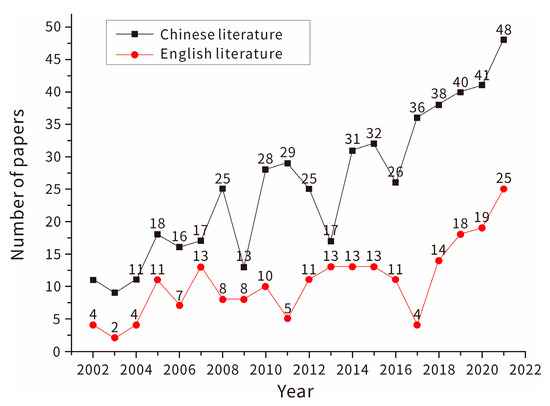
Figure 1.
Trend chart of annual publication volume of the literature.
3.2. Article Journal Analysis
The top ten journals in terms of the number of publications consist of three Chinese-language journals and seven foreign-language journals, which contain a total of 133 articles, occupying 18.52% of the total number of publications (Table 1). This shows that the dispersion of the journals that publish research papers on large-diameter timber in forests is high. Given the considerable disparity in the number of articles published in each journal, the top ten journals are deemed sufficiently representative; thus, they were selected for analysis. The journal of Forest Ecology and Management has a higher number of articles. Forest Ecology and Management and the Canadian Journal of Forest Research has a higher average citation frequency and publishes papers of higher quality.

Table 1.
Top 10 journals in terms of article volume.
3.3. Overview of the Research Team
3.3.1. Analysis of the Issuing Organization
The list of scientific research institutions with the top ten publications in CNKI is shown in Table 2. The Guangxi Forestry Research Institute is the organization with the most publications with 24 documents. The Tropical Forestry Experimental Center of the Chinese Academy of Forestry is the first in both total citation frequency and average citation frequency, and it is strong in the research field of large-diameter stands. Although the number of articles published is lower, the Fujian Academy of Forestry ranks second in total citations and average cited frequency per paper. Research institutions have regional distribution characteristics. The research institutes are characterized by geographical distribution, with four of the top ten research institutes coming from Guangxi and two from Fujian. According to the China Environmental Statistics Yearbook, the forest coverage rate of Guangxi and Fujian rank third and first, respectively, among the 31 provinces in China. Therefore, the high number of research organizations in these two provinces may be related to their large amount of forest resources.

Table 2.
The top 10 institutions with the highest number of publications in China.
In WOS (Table 3), the CSIR ranks in the top ten in terms of the number of papers sent. The United States Forest Service has the highest number of articles and pays more attention to the research on large-diameter stands. The Wageningen University and Research in the Netherlands and the Natural Resources Institute Finland (Luke) in Finland are in the top rank in terms of total citation frequency and average citation frequency, which are strong in the field of large-diameter stand research and attract the attention of scholars.

Table 3.
Top 10 institutions in terms of publications.
3.3.2. Country Analysis
We conducted mapping of national and regional cooperation networks based on WOS (Figure 2). The United States published the largest number of articles (50), followed by Brazil (20), Poland (18), Canada (17), Australia (16), and France (14). China ranked seventh with 12 articles; in addition, the United States had the largest node centrality (0.55), followed by the United Kingdom (0.39), which cooperated more closely with other countries, and Poland sent out a larger number of articles but cooperated less with other countries. The purple circle outside a node indicates its centrality is higher than 0.1, and its nodes are usually key hubs in the network, connecting two or more large groups of nodes.
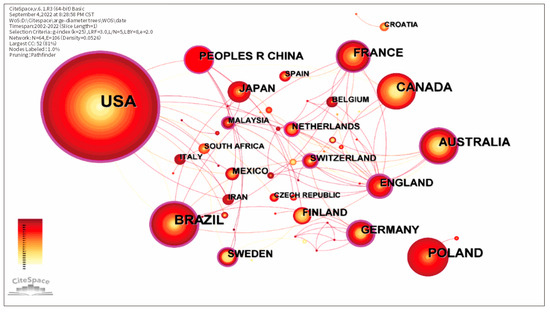
Figure 2.
Cooperative networks in countries where English-language articles are published.
3.4. Research Hotspots and Trends
Keywords are used to summarize and distill the core of the literature. By analyzing the frequency of keywords in the literature, it is possible to identify the keywords that appear with greater frequency, which can be regarded as research hotspots in the field [11].
3.4.1. Keyword Co-Occurrence Analysis
Keyword co-occurrence analyses in CNKI and WOS were conducted, respectively. The Chinese literature co-occurrence map (Figure 3) and the English literature co-occurrence map (Figure 4) were obtained. The high frequency of keywords such as “large diameter timber, fir, cultivation, eucalyptus, cultivation technology, directional cultivation” shows that large-diameter cultivation technology and breeding measures are the research hotspot of large-diameter timber, focusing on eucalyptus, fir, aspen, larch, Pinus koraiensis, Castanopsis hystrix, bamboo, and Masson pine large-diameter cultivation technology research. The high frequency of keywords such as “artificial forest, thinning, precious tree species, economic benefits, forest management, growth, diversity, the pattern” shows that the research is focused on thinning, precise formula fertilization, density control, developing forest care measures, promotion of the growth of large-diameter stand, improvement of the ecological benefits of large-diameter timber land, and economic benefits. The words “biodiversity and tropical forest” also appear frequently. The research focuses on keeping dead trees from rotting, generating wood residues, protecting species diversity, and improving the ecological benefits of forests. “Dynamics, stand” and other words appear frequently, as well. Research with these keywords focuses on dynamically monitoring the growth of large-diameter stands, improving the quality of large-diameter timber, and ensuring the safety of national wood production.
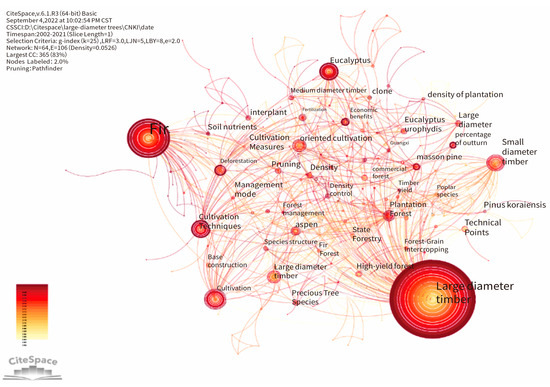
Figure 3.
Analysis of co-occurrence of keywords in the Chinese-language literature.

Figure 4.
Analysis of co-occurrence of keywords in the English-language literature.
3.4.2. Keyword Highlighting Detection
From the detection of emergent keywords, 15 Chinese emergent keywords (Figure 5) and 15 English emergent keywords (Figure 6) with high emergent intensity were obtained in the field of large-diameter timber stand research. According to the emergent keywords, large-diameter timber research can be divided into three stages:
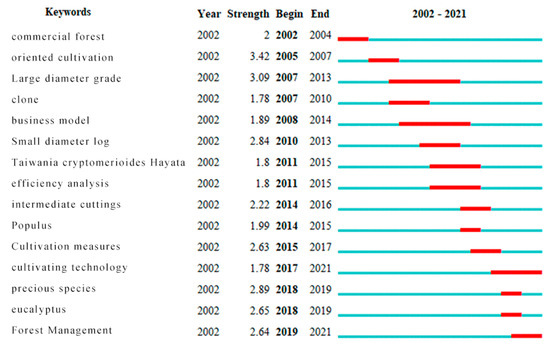
Figure 5.
Hot words in the Chinese-language literature research.
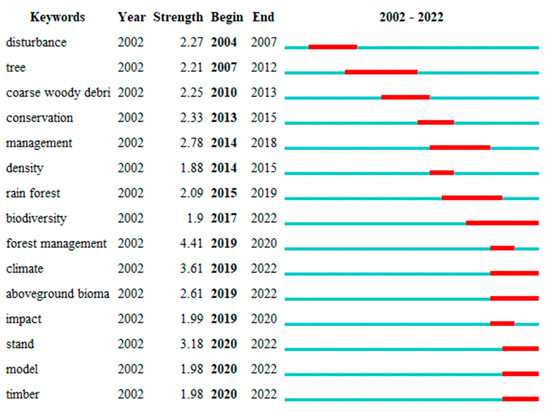
Figure 6.
Hot words in the English-language literature research.
- (1)
- In the early stage of the study, keywords such as “commercial forest, directional cultivation, large-diameter timber, clone” appeared with high frequency, and the focus of the study was to find excellent clones suitable for large-diameter timber cultivation to provide silvicultural materials to cultivate plantation forests efficiently and to satisfy the economic development and social progress. The words “disturbance, tree” indicate that disturbance affects the growth of large-diameter stands, and appropriate disturbance improves the quality of large-diameter stands.
- (2)
- In the middle stage of the study, the emergence of “business model, management, benefits analysis, small diameter timber, poplar, Taiwania flousiana” and other keywords indicate the focus on the compound cultivation mode of understory economic plants. The words “thinning, density, conservation and rain forest” show that the research focuses on determining the initial period of thinning and improving the quality of stands through different thinning strength and thinning retention methods to provide a basis for the operation of large-diameter timber stand. The emergence of words “coarse woody debris and biodiversity” indicates the focus on retaining dead wood to generate rough wood residues, improve the biodiversity of large-diameter stand, and maintain the function of the forest ecosystem.
- (3)
- In recent years, with the emergence of keywords such as “cultivation measures, cultivation techniques, precious tree species and eucalyptus”, the research focuses on the efficient cultivation mode of precious tree species such as eucalyptus and fir. The emergence of “forest management, climate, aboveground biomass, impact, stand, model, timber” indicates the focus on improving the productivity of large-diameter stand and reducing the impact of climate change on forest quality by adjusting forest structure and tree species structure.
In the research process of nearly 20 years, keywords such as “cultivation technology, forest management” have been highlighted for a long time, indicating that the business model and cultivation technology of large-diameter timber have always been the research hotspot in this field. The future research trend in this field is to improve the management mode of large-diameter stand, protect biodiversity, improve forest quality, and reduce the impact of climate change.
3.4.3. Keyword Cluster Analysis
We used the LLR algorithm in CiteSpace software to cluster the keywords. According to the index provided by CiteSpace, Modularity Q = 0.663 and Mean Silhouette = 0.8938. Modularity Q represents the cluster module value. Q > 0.3 means that the cluster structure is significant; S > 0.5 cluster type is reasonable, and S > 0.7 is convincing [12].
The keywords of Chinese-language literature were analyzed by clustering, and eight clusters were generated (Figure 7). Cluster 0, “fir”, focuses on technical measures for cultivating large-diameter fir timber and constructing fir commercial forests through forest conservation management. Cluster 1, “Large diameter timber”, Cluster 4, “Large diameter”, and Cluster 5, “Large diameter lumber”, focus on the production of large-diameter timber, prices, and the current supply and demand situation in the timber market, with an emphasis on effective cultivation of the focus on the effective cultivation of large-diameter timber commercial forests and the enhancement of productivity. Cluster 2, “poplar species”, through clonal selection, focuses on change to the diameter structure, promotion of the growth of large-diameter timber, and effective improvement of the economic benefits of large-diameter stand. Cluster 3, “Eucalyptus”, mainly focuses on the cultivation technology of large-diameter timber of eucalyptus. Based on the state-owned forest farm, different cultivation measures are adopted to build the raw material base of large-diameter timber forest and increase the timber forest area. Cluster 6, “cultivation”, focuses on the cultivation method of large-diameter timber. The economic and ecological benefits of large-diameter stand can be improved through directional cultivation by changing the cultivation technology, classifying the forest to form a large-diameter timber forest, promoting the sustainable development of the economic society, and reducing the import of wood in China. Cluster 7, “masson pine”, focuses on the cultivation technology of Masson pine.
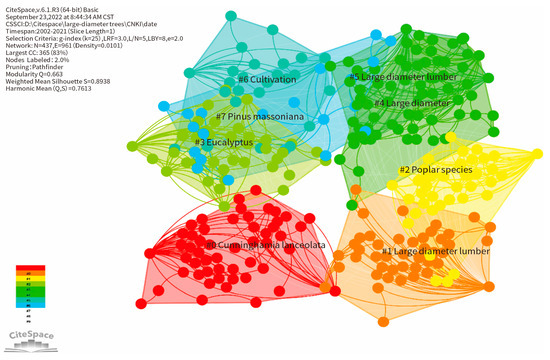
Figure 7.
Keyword clustering map of the Chinese-language literature.
The cluster analysis of English-language literature keywords using CiteSpace software, with Modularity Q = 0.6843 and Mean Silhouette = 0.8801, showed that the clustering results are convincing (Figure 8). Eight clusters were generated from this analysis. Cluster 0, “sustainable forestry”, focuses on the sustainable management of large-diameter timber stands. Cluster 1, “coarse woody debris”, indicates that the function of the forest ecosystem can be improved by tending and managing large-diameter stand, retaining dead trees, and then protecting biodiversity. Cluster 2, “wood quality”, focuses on the wood quality of large-diameter timber and climate change which affects the quality of trees and the forest structure. Cluster 3, “stand structure”, focuses on the stand structure of large-diameter forests to improve woodland biodiversity and stand structure through natural conservation and selective thinning. Clusters 4, “tree biomass”, and 6, “diameter growth”, focus on establishing the large-diameter timber growth model after stand cutting. UAV technology is currently used to investigate forest growth factors, conduct sustainable management of forests, change plant species and forest types, and affect a positive and effective change in ecological protection. Cluster 5, “spatial association”, focuses on the impact of pest disturbance on the spatial patterns of large-diameter stands and the impact of sustainable forest management on understory species diversity. Cluster 7, “forest management”, focuses on the forest management model to improve the stands’ economic benefits and reduce fire risk.
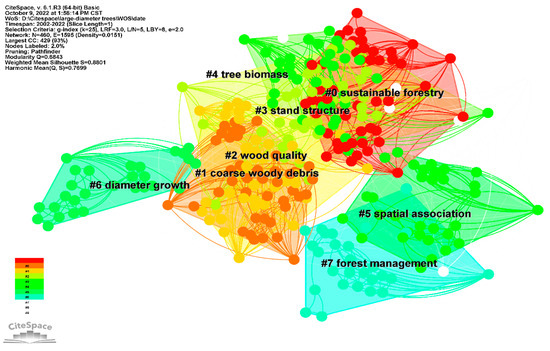
Figure 8.
Clustering map of keywords in the English-language literature.
4. Discussion
4.1. Research Trend of Large-Diameter Trees
From 2002 to 2021, the number of documents published in Chinese and English increased yearly. The increasing trend of Chinese-language literature can be divided into three stages. In 2004, the State Forestry Administration issued the Work Points of State Forestry Administration 2004, proposed the construction speed of large-diameter timber forest base, organized the preparation of special plans for precious tree species and large-diameter timber forest, and made the number of articles exceed 15 in 2005. The Construction Plan of National Wood Strategic Reserve Production Base (2013–2020) was presented as the fundamental measure to alleviate the contradiction between supply and demand of timber and maintain safety [13]. In 2014, the number of published documents exceeded 30; in 2016, natural forest cutting was stopped in China. In the same year, Fujian Agriculture and Forestry University presided over the “fir efficient cultivation technology research project”, opening the large-diameter timber species of efficient cultivation technology research, resulting in a large increase in the number of large-diameter timber articles. From 2002 to 2017, the number of English-language documents increased slowly, but after 2018, the number of English-language documents increased significantly, which is related to the large number of English-language documents published by Chinese authors.
The keyword co-occurrence analysis indicates that the cultivation technology of large-diameter timber forests, forest management, development of understory economy technology, and dynamic monitoring of the growth of large-diameter timber forests are the focus of the research, which is related to the increasing global concern about climate change and ecosystems. Coping with climate change has made the goal of forest management more extensive, and wood production must be coordinated with the conservation of forest ecosystems [14]. Yanshu et al. found that stand density and soil fertility are the dominant factors in developing large-diameter timber [15], and the availability of soil nutrients directly affects the growth of large-diameter stand. The study of large-diameter timber cultivation found that retaining the appropriate thinning density and increasing nitrogen and phosphorus fertilizers under a high stand index could enhance the volume and rate of large-diameter timber production [16]. Based on remote sensing technology, forest data such as tree height, DBH, and number of trees can be obtained, which can help people manage and continuously monitor forests, especially in optimizing wood transportation [17]. Regular stand monitoring, statistical quality control, and the development of the understory economy are good ways to harmonize ecological and economic objectives in forest management and promote a balance between ecological and economic benefits [18].
The analysis of the frequently encountered words concludes that choosing suitable seed sources, improving the management mode of large-diameter timber forests, and innovating large-diameter timber cultivation techniques are the research trends of large-diameter timber forests. Since the implementation of the natural forest protection project in China, the source of large-diameter timber has gradually changed to plantation forests [19], leading to a gradual change in the management mode of plantation forests to a multi-objective management mode that combines timber use and ecological benefits [20]. An essential component of the plantation ecosystem is understory vegetation, which plays an important role in the nutrient circulation of the plantation ecosystem [21,22]. Research on fir woodlands has shown that the lack of techniques for large-diameter timber cultivation and understory economic development can lead to lower overall benefits of fir woodlands [23]. The operation and establishment of Chinese fir, broad-leaved mixed forest, the protection of understory vegetation, selective cutting [24], and other forestry measures can improve the structure of forest stands, promote forest regeneration, and contribute to the maintenance of soil nutrients [25]. After interseeding Liriodendron chinense in large-diameter timber near-mature forests, the growth of the forest can be effectively promoted [26]. The aforementioned studies coincide with the improvement of the management mode of large-diameter timber forests mentioned in the analysis of the frequently encountered words.
Through keyword clustering analysis, it was determined that the research focuses on fir, eucalyptus, Masson pine, large-diameter timber cultivation technology and cultivation measures, forest management, forest quality, and stand structure, corresponding to the previous co-occurrence analysis and frequent word analysis. Directed cultivation of large-diameter timber in plantation forests is a cultivation system that runs through all stages from seed selection to forest establishment. Its key contents are gathered in the selection of site conditions, genetic control of tree species, control of stand density, fertilizer management, and control of rotation period [27,28,29]. For seedling selection, stand selection, stand density control, planting technology, follow-up management, and other operational measures to cultivate technology research, low density and high-status index are more suitable for cultivation of fir large-diameter timber [30]. Eucalyptus large-diameter timber cultivation technology research focuses on germplasm control, stand control, different planting densities, the content of the fertilizer control, and multiple prevention and control technologies of integrated application.
From a global perspective, China currently ranks fifth in the world in terms of forest area and sixth in terms of forest reserves. However, China’s per capita forest area is 0.16 hm2, which is less than one third of the world’s per capita level (0.60 hm2), and China’s per capita forest reserve is 12.35 m3, which is only one sixth of the world’s per capita level (79.65 m3). Furthermore, China’s forest age structure is still irrational, with the proportion of young and middle-aged forests being as high as 63.95%, and the proportion of forest reserve being only 40.80%. China’s position in the global distribution of forest resources and the limited per capita forest resources have influenced the emergence of research hotspots and trends in large-diameter timber in China. These factors have combined to facilitate the advancement of large-diameter timber research in the direction of improving timber quality and stock while meeting the needs of economic development [7].
4.2. Domestic and International Research Differences
The development of forestry policy in each country is influenced by the needs of their respective economies and societies. In China, for example, the focus of forestry policy may be on supporting rapid economic growth, which leads to high demand for large-diameter timber and influences the direction of research. In contrast, in many countries, the focus of forestry policies is on sustainability and ecological conservation, which leads to research exploring how forestry activities can be carried out without damaging ecosystems [31].
The allocation and investment of research resources also influence the focus of research. China’s assessment of the benefits of forest certification is still relatively homogeneous, and therefore more resources are invested in cultivation techniques and stand management to meet the demand for large-diameter timber. Conversely, foreign research has received more investment in ecosystem services and biodiversity conservation. It is anticipated that as the concept of sustainable forestry gains traction in China, large-diameter timber research will increasingly prioritize the balance between ecological and social benefits, thereby facilitating the sustainable utilization of forest resources [32].
4.3. Forestry Commercialization and Circular Economy
Large-diameter timber represents a high-value-added forestry resource, playing an important role in the commercialization of forestry and circular economy. In a circular economy, emphasis is placed on the efficient flow and multiple utilization of resources throughout the supply chain, which is in line with the value chain extension strategy in forestry commercialization. We can adopt the principle of “Cascade utilization”. By prioritizing the use of high-value-added wood products and gradually downgrading them for other uses, it is possible to maximize the use of resources. For example, in the construction industry, wood from the demolition of old buildings can be reprocessed for use in furniture making or other structural materials, thus extending the life of the wood [33,34].
In addition, if we introduce the concept of circular economy in the process of commercializing large-diameter timber for forestry, we can increase the utilization rate of wood and forestry by-products and significantly improve the efficiency of resource utilization. For example, Finnish forest industry production demonstrates the practice of closed-loop thinking and circular material flows, deeply embedding the circular economy concept in company business models [35]. In addition, we can convert waste and by-products from the logging process into products with higher market value, such as biofuels, wood fiber boards, or other bio-based materials, which not only reduces waste but also creates new economic opportunities [33].
The integration of large-diameter trees into commercialization and circular economy concepts is an important step towards the sustainable development of the forest industry. It also significantly reduces the burden on the environment and promotes the healthy functioning of ecosystems [36,37].
5. Conclusions
5.1. Summary
The number of publications in Chinese and English on large-diameter timber stands has increased yearly. Researchers have published research results on large-diameter timber in a more concentrated manner in journals such as Forest Ecology and Management.
The Guangxi Academy of Forestry has a large number of documents, and the Tropical Forestry Experimental Center of the Chinese Academy of Forestry has strong research strength in the field of large-diameter timber research. The United States has a large number of United States Forest Service publications; the Wageningen University and Research in the Netherlands and the Natural Resources Institute Finland (Luke) in Finland are strong in the field of forest large-diameter timber research, with the largest number of papers published in the United States and good cooperation with other countries.
Keyword co-occurrence analysis showed that the cultivation technology and cultivation measures of large-diameter timber, effective forest conservation management, stand structure of large-diameter timber forests, and dynamic monitoring of the growth of large-diameter timber forests are research hotspots in the field. Expansion word analysis showed that choosing suitable seed sources, improving the management mode of large-diameter timber forests, and innovating large-diameter timber cultivation techniques are forest large-diameter timber research trends. Keyword clustering analysis showed that research focuses on the retention of dead standing trees, conservation of biodiversity, survey of forest growth factors using UAV technology, effects of climate change on forest structure, forest restoration after thinning, and effects of pest and disease disturbances on spatial patterns of large-diameter timber stands.
In addition, the growth of large-diameter timber is influenced by a variety of environmental factors, including soil, climate, and precipitation. These factors vary significantly across different regions, which leads to the geographical nature of the research results and makes it difficult to generalize them globally. From the keyword clustering map of the English-language literature, it can be seen that the clusters of “diameter growth” and “spatial association” have less overlap with other clusters of large-diameter timber. Therefore, it is recommended that future research in the field of large-diameter trees strengthen mutual cooperation among subjects in order to avoid unbalanced development in this field and to overcome the limitations of research and application. Furthermore, it is proposed that international cooperative research projects and data sharing be strengthened in order to expand the geographical coverage of research.
5.2. Suggestions
Large-diameter timber stands play an important role in maintaining ecosystem balance and timber supply and enhancing the function of forest carbon sinks. Many scholars have paid attention to the study of large-diameter stands. China is the world’s largest wood consumer. Maintaining the sustainable development of large-diameter wood resources and maximizing the forest’s ecological function is an important problem to be solved urgently. By discussing the research trend and hotspots of large-diameter forests, the following suggestions are proposed for the future research of large-diameter forests in China:
- (1)
- Improve the technical measures of large-diameter timber cultivation from the aspects of tree species selection, site control technology, density control technology [38], fertilizer technology, and nurturing and intercutting.
- (2)
- Improve the management mode of large-diameter timber forests, replace pure forests with mixed forests, and develop an understorey economy mode in order to achieve the dual benefits of economy and ecology. It is further recommended that the planting of native tree species and precious tree species be increased.
- (3)
- Apply UAV and remote sensing technology to long-term monitoring of DBH and tree high growth factor of large-diameter stand. In this research, such approach provided data support for forest managers, shortened the thinning period, and improved the economic and ecological benefits of large-diameter stand.
- (4)
- In the future, research on the influence of different land conditions on the growth of large-diameter timber should be strengthened in order to optimize the selection of cultivation areas. Concurrently, research on the optimal seed source selection and genetic improvement of large-diameter tree species should be intensified in order to enhance tree growth and timber quality.
Author Contributions
Conceptualization, F.H. and X.J.; formal analysis, F.H. and Y.Y.; resources, X.J.; writing—original draft preparation, F.H. and C.Z.; writing— review and editing, Y.Z. and M.L.; supervision, X.J. and Z.S.; funding acquisition, X.J. All authors have read and agreed to the published version of the manuscript.
Funding
This work was supported by the Science and Technology Program from Forestry Administration of Guangdong Province (2022KJCX015), Science and Technology Program from Forestry Administration of Guangdong Province (2023KJCX004).
Institutional Review Board Statement
Not applicable.
Informed Consent Statement
Not applicable.
Data Availability Statement
The data presented in this study are available on request from the corresponding author. The data are not publicly available due to privacy.
Conflicts of Interest
The authors declare no conflicts of interest.
References
- Wu, C.P.; Jiang, B.; Yuan, W.G.; Shen, A.H.; Yang, S.Z.; Yao, S.H.; Liu, J.J. On the Management of Large diameter Trees in China’s Forests. Forests 2020, 11, 111. [Google Scholar] [CrossRef]
- Yu, F.J.; Tian, D.; Hou, Z.Y.; Wang, M.G.; Zhang, N.L. Progress of global forest carbon sink function assessment. J. Beijing For. Univ. 2022, 44, 880. [Google Scholar]
- Yang, Y.H.; Shi, Y.; Sun, W.J.; Chang, J.F.; Zhu, J.X.; Chen, L.Y.; Wang, X.; Guo, Y.P.; Zhang, H.T.; Yu, L.F.; et al. Terrestrial carbon sinks in China and around the world and their contribution to carbon neutrality. Sci. China Life Sci. 2022, 65, 861–895. [Google Scholar] [CrossRef] [PubMed]
- Cook-Patton, S.C.; Leavitt, S.M.; Gibbs, D.; Harris, N.L.; Lister, K.; Anderson-Teixeira, K.J.; Briggs, R.D.; Chazdon, R.L.; Crowther, T.W.; Ellis, P.W.; et al. Mapping carbon accumulation potential from global natural forest regrowth. Nature 2020, 585, 545–550. [Google Scholar] [CrossRef] [PubMed]
- Ni, Y.; Eskeland, G.S.; Giske, J.; Hansen, J.P. The global potential for carbon capture and storage from forestry. Carbon Balance Manag. 2016, 11, 3. [Google Scholar] [CrossRef] [PubMed]
- Kiomars, S.; CarolynA, C. Tree-Related Microhabitats: A Comparison of Managed and Unmanaged Oriental Beech–Dominated Forests in Northern Iran. For. Sci. 2020, 66, 747–753. [Google Scholar]
- Guang, N.Y.; Zhao, H.L.; Liu, M. Analysis of the Driving Factors and Potential of Forest Resource Growth in China—Based on the Results of the Ninth National Forest Resources Inventory. J. Porestry Grassl. Policy 2022, 2, 64–71. [Google Scholar]
- Zhang, Y.Y.; Zhang, M.; Ceng, H. Current Situation, Hot Spots and Prospects of Political Ecology Research—A Bibliometric Analysis Based on CiteSpace. J. Party Sch. CPC Ningbo Munic. Comm. 2020, 42, 77–86. [Google Scholar]
- Chen, C.M. CiteSpace II: Detecting and visualizing emerging trends and transient patterns in scientific literature. J. Am. Soc. Inf. Sci. Technol. 2006, 57, 359–377. [Google Scholar] [CrossRef]
- Zheng, C.J.; Yuan, J.F.; Zhu, L.; Zhang, Y.J.; Shao, Q.H. From digital to sustainable: A scientometric review of smart city literature between 1990 and 2019. J. Clean. Prod. 2020, 258, 120689. [Google Scholar] [CrossRef]
- Zhang, J.; Sun, X.L.; Zhang, Y.J. Analysis of disciplinary hotspots for the development of polyolefin functionalization. New Mater. Chem. Ind. 2022, 50, 29–34. [Google Scholar]
- Zhang, C.L.; Liu, X.K.; Hua, G.D.; Jia, X.R.; Yan, Y. Visualization and analysis of wetland nature education research based on Citespace knowledge graph. Wetl. Sci. Manag. 2022, 18, 28–32. [Google Scholar]
- Liao, Y.J. Reflections on forest management under the situation of reform of state-owned forest farms in Guangdong. Anhui Agric. Sci. 2018, 46, 127–128. [Google Scholar]
- Toshiya, Y.; Sayoko, N.; Misato, N.; Natsumi, H.; Taiki, I.; Hiromitsu, U.; Haruka, Y.; Hisashi, M.; Futoshi, N. Structural Complexity and Ecosystem Functions in a Natural Mixed Forest under a Single-Tree Selection Silviculture. Sustainability 2017, 9, 2093. [Google Scholar]
- Yan, Z.; Wang, R.H.; Deng, H.Y.; Zheng, H.Q.; Hu, D.H.; Wei, R.P. Study on the factors affecting large diameter timber success of Chinese fir in Nanling mountainous area. J. South China Agric. Univ. 2021, 42, 80–89. [Google Scholar]
- Zhao, M.Z.; Wang, L.Y.; Liu, J.; Zou, X.H.; Zheng, H.; Fan, F.J.; Ma, X.Q.; Lin, K.M.; Lin, M. Effects of thinning and fertilization on growth and species structure of Chinese fir mature forest. J. Zhejiang Agric. For. Univ. 2022, 39, 338–346. [Google Scholar]
- Farzam, T.; Mehrdad, N.; Angela LO, M.; Rodolfo, P. Long-term impact of selection cutting management on frequency of stem deformity in mixed beech forests of Northern Iran. Drewno 2021, 64, 5–26. [Google Scholar]
- Peter, S.; Karel, K. Acquisition of Forest Attributes for Decision Support at the Forest Enterprise Level Using Remote-Sensing Techniques—A Review. Forests 2019, 10, 273. [Google Scholar]
- Carle, J.; Holmgren, P. Wood from Planted Forests a Global Outlook 2005–2030. For. Prod. J. 2008, 58, 6–18. [Google Scholar]
- Qin, W.Y. Effects of formulated fertilization on large diameter timber in Chinese fir plantation forest. Jiangsu Agric. Sci. 2021, 49, 98–102. [Google Scholar]
- Du, Z.; Ca, X.H.; Bao, W.K.; Chen, K.; Pan, H.L. A review of the effects of understory vegetation on upper trees. J. Appl. Ecol. 2016, 27, 963–972. [Google Scholar]
- Li, Y.L.; Wang, S.L.; Yan, S.K. Short-term effects of Chinese fir plantation forest culling understory vegetation on nutrient cycling in the apoplastic layer. J. Appl. Ecol. 2011, 22, 2560–2566. [Google Scholar]
- Luo, Y.; Lin, G.L. Discussion on the current situation of Chinese fir forest management and cultivation in southeastern Yunnan--Taking Nanlao Township, Maguan County, Wenshan Prefecture as an example. Inn. Mong. For. Surv. Des. 2022, 45, 21–23. [Google Scholar]
- Jucker, T.; Sanchez, A.C.; Lindsell, J.A.; Allen, H.D.; Amable, G.S.; Coomes, D.A. Drivers of aboveground wood production in a lowland tropical forest of West Africa: Teasing apart the roles of tree density, tree diversity, soil phosphorus, and historical logging. Ecol. Evol. 2016, 6, 4004–4017. [Google Scholar] [CrossRef] [PubMed]
- Lu, J.; Wu, L.H.; Zheng, H.; Zhang, X.; Fei, Y.C.; Cao, S.J.; Ji, C.S.; Cao, G.Q. Effects of different understory vegetation management practices on soil fungal community structure in Chinese fir large diameter timber stands. J. Appl. Environ. Biol. 2021, 27, 938–948. [Google Scholar]
- He, J.M. Effects of different management measures on Chinese fir near-mature forests. Subtrop. Soil Water Conserv. 2021, 33, 36–39, 43. [Google Scholar]
- Felipe, C.C.; Arne, P.; Roque, R.S. Impacts of thinning on structure, growth and risk of crown fire in a Pinus sylvestris L. plantation in northern Spain. For. Ecol. Manag. 2009, 257, 1945–1954. [Google Scholar]
- Ren, Y.M.; Chen, M.J.; Li, H.T.; Hou, Z.J.; Liu, Y.H.; Liu, A.Q. Effects of formulated fertilization on large diameter timber species structure in Chinese fir near-mature forest. J. For. Environ. 2021, 41, 18–25. [Google Scholar]
- Sun, B.B.; Chen, X.B.; Zhang, Q.C.; Huang, B.J.; Xiao, Z.J.; Li, D.H.; Yi, H.Y. Discussion on the near-natural cultivation of large diameter timber commercial forests of red pine in China. World For. Res. 2021, 34, 84–89. [Google Scholar]
- Huang, L.; Wang, G.; Yang, B.; Zhu, Y.Y.; Zhao, G.Z.; Yang, S.K. Relationship between Chinese fir large diameter timber success and topography and soil nutrients. J. Fujian Agric. For. Univ. (Nat. Sci. Ed.) 2021, 50, 619–623. [Google Scholar]
- Guo, L.D.; Wang, N.; Chen, Q.; Zhang, H.; Wang, L.Y.; Guo, W.; Zhang, X.Z.; Li, Y.Q. Analysis of hotspots and trends of forestry research at home and abroad. For. Sci. Technol. Bull. 2022, 6, 45–48. [Google Scholar]
- Ma, S.; Tian, M.H.; Hou, F.M.; Wu, H.M.; Miu, D.L. Research hotspots and trends of forest certification at home and abroad based on literature analysis. J. Beijing For. Univ. (Soc. Sci. Ed.) 2023, 22, 70–76. [Google Scholar]
- Gagnon, B.; Tanguay, X.; Amor, B.; Imbrogno, A.F. Forest Products and Circular Economy Strategies: A Canadian Perspective. Energies 2022, 15, 673. [Google Scholar] [CrossRef]
- Lazaridou, D.C.; Anastasios, M.; Marios, T. Exploring Environmental and Economic Costs and Benefits of a Forest-Based Circular Economy: A Literature Review. Forests 2021, 12, 436. [Google Scholar] [CrossRef]
- Annukka, N. Transition in the Finnish forest-based sector: Company perspectives on the bioeconomy, circular economy and sustainability. J. Clean. Prod. 2019, 209, 1294–1306. [Google Scholar]
- Song, C.F.; Zhang, C.; Zhang, S.C.; Hui, L.; Yrjälä, K.; Muthusamy, R.; Du, Y.Q.; Zhang, Y.; Zheng, H.B.; Damià, B. Thermochemical liquefaction of agricultural and forestry wastes into biofuels and chemicals from circular economy perspectives. Sci. Total Environ. 2020, 749, 141972. [Google Scholar] [CrossRef]
- Wiebke, R.; Vinit, P.; David, R. Circular Business Models for the Bio-Economy: A Review and New Directions for Future Research. Sustainability 2019, 11, 2558. [Google Scholar]
- Sun, J.J.; Jiao, W.X.; Wang, Q.; Wang, T.L.; Yang, H.Q.; Jin, J.X.; Feng, H.L.; Guo, J.H.; Feng, L.; Xu, X.; et al. Potential habitat and productivity loss of Populus deltoides industrial forest plantations due to global warming. For. Ecol. Manag. 2021, 496, 119474. [Google Scholar] [CrossRef]
Disclaimer/Publisher’s Note: The statements, opinions and data contained in all publications are solely those of the individual author(s) and contributor(s) and not of MDPI and/or the editor(s). MDPI and/or the editor(s) disclaim responsibility for any injury to people or property resulting from any ideas, methods, instructions or products referred to in the content. |
© 2024 by the authors. Licensee MDPI, Basel, Switzerland. This article is an open access article distributed under the terms and conditions of the Creative Commons Attribution (CC BY) license (https://creativecommons.org/licenses/by/4.0/).